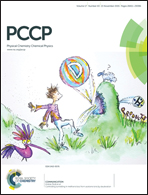Theoretical model of the interaction of glycine with hydrogenated amorphous carbon (HAC)
Abstract
A theoretical model of hydrogenated amorphous carbon (HAC) is developed and applied to study the interaction of glycine with HAC surfaces at astronomical temperatures. Two models with different H content are tried for the HAC surface. The theory is applied at the Density Functional Theory (DFT) level, including a semiempirical dispersion correlation potential, d-DFT or Grimme DFT-D2. The level of theory is tested on glycine adsorption on a Si(001) surface. Crystalline glycine is also studied in its two stable phases, α and β, and the metastable γ phase. For the adsorption on Si or HAC surfaces, molecular glycine is introduced in the neutral and zwitterionic forms, and the most stable configurations are searched. All theoretical predictions are checked against experimental observations. HAC films are prepared by plasma enhanced vapor deposition at room temperature. Glycine is deposited at 20 K into a high vacuum, cold temperature chamber, to simulate astronomical conditions. Adsorption takes place through the acidic group COO− and when several glycine molecules are present, they form H-bond chains among them. Comparison between experiments and predictions suggests that a possible way to improve the theoretical model would require the introduction of aliphatic chains or a polycyclic aromatic core. The lack of previous models to study the interaction of amino-acids with HAC surfaces provides a motivation for this work.


 Please wait while we load your content...
Please wait while we load your content...